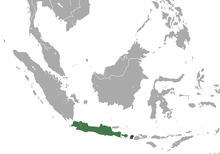Black crested langur
| Black crested langur | ||||||||||||
|---|---|---|---|---|---|---|---|---|---|---|---|---|

Black crested langur ( Trachypithecus auratus ) |
||||||||||||
| Systematics | ||||||||||||
|
||||||||||||
| Scientific name | ||||||||||||
| Trachypithecus auratus | ||||||||||||
| ( É. Geoffroy , 1812) |
The black crested langur ( Trachypithecus auratus ) is a species of primate from the group of slender monkeys that is widespread in Indonesia .
features

Black crested langurs are slender primates with a long tail. Their head body length is 45 to 65 centimeters, the tail is up to 90 centimeters long. The weight varies between 5 and 9 (average 7) kilograms. A distinction is made between two differently colored variants ( color polymorphism ): the more common has a black coat with light hair tips on the limbs and on the head. The rarer color variant is orange-brown, although the limbs and the belly can be yellowish. The skin is black in the dark morph and unpigmented or spotted in the orange. The face is surrounded by a wreath of hair pointing forward.
distribution and habitat
The black crested langur lives on the Indonesian island of Java as well as on the smaller islands of Bali , Lombok and Nusa Barung . The habitat of this species are forests.
Way of life
These primates are diurnal tree dwellers. They are skilled climbers who mainly move four-legged through the branches. They live in groups of 6 to 21 animals. These groups consist of one or two males, several females and their offspring. The remaining males live solitary or in bachelor groups.
food
Black crested langurs are mainly herbivores. They consume leaves (for example of the teak tree ), fruits, flowers and buds, and to a lesser extent also insect larvae. Chunks of earth and sand, which are also swallowed, are used to mechanically break down food and absorb salts and minerals. Like all slender monkeys, they have a multi-chambered stomach for a better breakdown of the difficult to digest plant food. Large salivary glands also serve this purpose.
Reproduction
Reproduction can take place all year round. After a gestation period of around 170 days, the female usually gives birth to a single young. This weighs around 300 to 400 grams at birth and, like all crested langurs, initially has an orange-yellow fur. Not only the mother takes care of the offspring, but also the other females. They pass the boy around, play with it and carry it. It is weaned after 12 to 15 months and reaches sexual maturity at three to four years of age. When reaching sexual maturity, males have to leave their birth group, females, however, usually remain in it for their entire life. Life expectancy is around 20 years in the wild and 30 years in human care.
Danger
Black crested langurs are threatened in their population. Their home island Java is very densely populated by people, their area of distribution is reduced and fragmented. The main threat is habitat destruction, the species is in the red list of the IUCN as endangered ( endangered listings).
Systematics
Two subspecies were distinguished: T. a. auritus in the middle and east of Java and T. a. mauritius in the west of the island (there are no orange morphs in this subspecies). The latter has since become a separate species (see Western crested langur ( Trachypithecus mauritius )).
literature
- Thomas Geissmann : Comparative Primatology. Springer-Verlag, Berlin a. a. 2003, ISBN 3-540-43645-6 .
- Ronald M. Nowak: Walker's Mammals of the World. 6th edition. Johns Hopkins University Press, Baltimore MD 1999, ISBN 0-8018-5789-9 .
- Don E. Wilson, DeeAnn M. Reeder (Eds.): Mammal Species of the World. A taxonomic and geographic Reference. Johns Hopkins University Press, Baltimore MD 2005, ISBN 0-8018-8221-4 .
Individual evidence
- ↑ Trachypithecus auratus in the endangered Red List species the IUCN 2006. Posted by: A. Eudey & Members of the Primate Specialist Group, 2000. Accessed April 16 of 2008.


